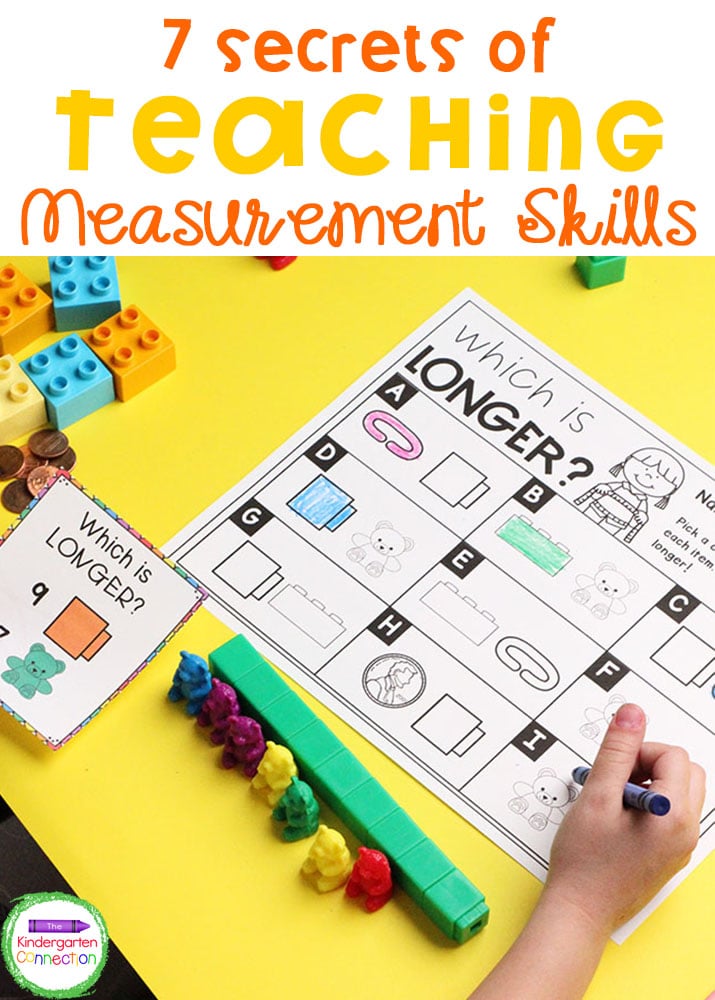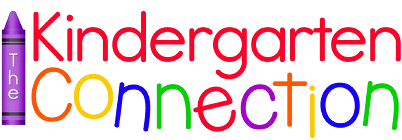The Secrets of Developing Measuring Skills
This post contains affiliate links for your convenience. View our full disclosure policy here.
Can your students measure? It’s not the easiest skill to teach. Measurement requires dexterity, exactness, and coordination, as well as basic number sense skills, making measuring concepts difficult for some children. But it doesn’t have to be. Check out these important little-known secrets for teaching measuring skills!
*Grab our Graphing and Measurement Activities for Pre-K & Kindergarten for tons of hands-on, easy-prep learning fun!

The Secrets of Developing Measuring Skills
Teaching math is an enormous task, and with the new changes in adopted state standards, the bar for teachers has risen even higher. That’s because there is a lot that goes into teaching math. Mathematicians indicate there are five primary disciplines of math, which are as follows:
- number sense – the development of a deep understanding of numbers and the number system, to compose and decompose numbers and understand their various relationships
- algebra – the understanding of patterns and relationships, including sorting and categorizing
- geometry – the understanding of spatial relationships, prepositional terms, and the properties of two and three-dimensional shapes
- measurement – the ability to make comparisons and order, understanding measurable attributes
- data analysis and probability – understanding data as a means of conveying organized information and understanding that certain variables affect data
Exclude one of those components and children may suffer in their math skills and experience unnecessary difficulty in learning math.
Developing measuring skills is just one step to effective mathematics instruction. Following this, will be more posts about the five disciplines of math and how teachers can be sure to include each within their math instruction.
What Are Measuring Skills?
Measuring skills encompass all the skills required for a child to effectively measure something. It is the knowledge of how to measure the physical attributes of objects including how to appropriately use measurement tools and proper techniques. One cannot be taught without the other.
Why are Measuring Skills so Important?
Consider your daily routine and think about how frequently you measure things.
- When pouring a bowl of cereal, you pour an amount you think you can eat. Then you add just the right amount of milk, not so much that the bowl of cereal overflows and not so little that some bites are dry, but just the right amount.
- When the gas light on your car turns on you can estimate how many miles you have until empty based on your gas mileage and the size of your gas tank.
- When shopping for new furniture you can measure the size of your “home theater” to see if those black, ver-stuff recliners really will fit next to the sectional.
These are examples of how an adult might measure things on a day-to-day basis, and here is what it looks like for young children.
- When washing hands after playing in the mud… will one pump of soap do, or are two pumps needed?
- When filling a cup of water from the refrigerator after playing in 90 degree heat, will a small cup do, or is maybe a larger glass of water better?
- When cutting a piece of yarn for a new kitten to play with, will just a few inches do, or would a few feet be better?
Whether formal or informal, we are constantly measuring things.
But… Teaching Measuring Skills is Hard
Teaching measurement often requires a lot of new vocabulary as well as learning how to use new tools. It’s a lot of information for children to remember without repeated, hands-on practice.
Here are some measuring skills often developed in early education:
- comparing objects by size (big, bigger, biggest)
- comparing objects by length, height, and weight
- comparing groups of objects and understanding that a lesser number is also a lesser quantity
- understanding basic concepts of time, such as this morning or yesterday, or in a minute
- using non-standard forms of measurement
How are Measuring Skills Developed?
Practice. Through lots and lots of practice. The reason primarily being that teaching measurement also requires teaching new vocabulary and how to use new tools, both of which takes extra and repeated practice.
What are Some Tips for Teaching Measuring Skills?
For success in teaching measurement, try some of these tips:
- Provide authentic and real-life experience whenever possible.
- Allow for practice.
- Use new mathematical language frequently.
- Teach multiple strategies, allowing children to choose the strategy that makes the most sense to them.
- Allow children to move and use their newest skills.
- Encourage students to talk about math and explain their thinking, even if their answer is wrong.
- Provide manipulatives for problem solving, rather than pencils and paper.
- Allow time for children to compare their work and work with others.
- Ask leading questions when teaching.
*Guest post by Sarah from Stay at Home Educator
Want unlimited access to even MORE of our activities and resources? Join us in the Print and Play Club!
Your planning will be so much easier with instant access to:
- hundreds of printables
- every TKC resource
- video lessons
- a digital games vault
- Pre-K and TK Scope & Sequence
- a PLAYlist of fun songs AND activities
- professional development
- additional teacher resources…
Be sure to request an invitation so that you don’t miss your chance to be part of the best early childhood club around!
- The Literacy-Rich Classroom - December 15, 2022
- Teaching Phonics – Your Questions Answered - November 17, 2022
- 22 Telltale Signs of a Reading Disability - November 2, 2022



Hi
I am a new home schooling Mom and am trying to bridge the gap of what my child may have missed during formal school. Please kindly add me
Priscilla,
Hi there! We have tons of amazing resources for Pre-K and Kindergarten in the Print and Play Club. We open the doors to the club a couple times during the year. If you would like to be added to the list so that you are notified the moment the doors open then just click the link below! 🙂
https://thekindergartenconnection.lpages.co/print-and-play-club-waitlist/